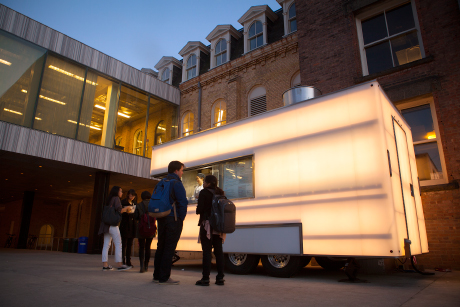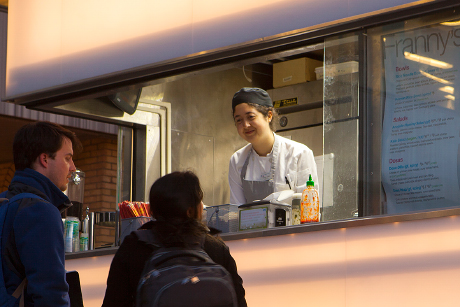Franny's food cart now serving near Sibley Hall
By Daniel Aloi


A new food cart designed and operated by students has been serving the campus community from the plaza behind Sibley Hall since late August.
The cart is the result of a student-led project for the College of Architecture, Art and Planning (AAP) and is named for donor Frances Shloss ’44, B.Arch. ’45.
Staffed by students and managed by the Statler Hotel, Franny’s features a menu of wraps and sandwiches, dumplings, rice bowls, crepes, salads, iced coffee, tea and a few desserts.
“AAP reached out to the Hotel School to be the operator,” said Gregory Mezey ’09, director of food and beverage at the Statler Hotel. “We weighed the pros and cons and thought it was a good opportunity to do something that has an entrepreneurial spirit, and this provides our students with a new venue.”
Food trucks have become increasingly popular, he said. “We came up with a concept menu and built what has evolved into Franny’s.”
The menu is “a mix of Korean, Vietnamese and Indian, and a splash of Latin American and Mexican flavors,” Mezey said. “We thought it was an underrepresented cuisine on campus and a really popular and successful one locally.”
Graduate and undergraduate students from all three AAP disciplines were involved in every phase of the project, from ideas to installation, saw it through to completion over a series of construction delays and kept a blog on their progress.
Food cart history
There have been mobile and permanent dining facilities at the north end of Cornell’s Arts Quad since the late 19th century, when The Sibley Dog, a local vendor’s wagon behind Sibley Hall, served hot dogs and other fare as one of only four food options then on campus. The Dog became the Campus Restaurant, in a wooden building that was removed in 1911 to make way for Rand Hall. It was rechristened the Sibley Pup and moved to the basement of Sibley Hall, sold cigars as well as food and was privately managed until 1915 when it became a university dining facility that lasted until 1921. The College of Architecture moved from White Hall to the remodeled Sibley Hall in 1959, and the former Pup has been the site of The Green Dragon café since 1968.
The project began with a design charette and brainstorming exercise in February 2012, co-organized by Piotr Chizinski, MFA ’13, and Benjamin Cummins, MRP ’13. Three design teams then presented their ideas to Shloss, and a faculty jury selected an initial concept for the cart by designers Alison Nash, B.A., BFA ’98, M.Arch. ’14, and Mia Kang, M.Arch. ’14.
Over the summer of 2012, Nash, Chizinski and Nicholas Cassab-Gheta, B.Arch. ’14, worked to finalize the design and the related construction documents with faculty adviser Luben Dimcheff, B.Arch. ’99.
“The schematic concept was that it would be an ice cube or a glass box that would glow,” Cassab-Gheta said.
Known as the “Glow Truck” since the design stage, the cart’s translucent outer shell is lit from the inside at night by an array of dimmable LEDs. The modernist design complements nearby Milstein Hall. The cart was fabricated by craftsmen at Stonewell Bodies in Genoa, N.Y., which specializes in veterinary and farrier trailers.
“The overarching concept is for the ‘glow’ truck to serve as a beacon to draw passersby into our new AAP neighborhood underneath Milstein and behind Sibley Hall,” Nash said. “The truck can be seen by students walking from North Campus to the Arts Quad through the undercroft of Milstein Hall, and from buses and cars driving on University Avenue. We wanted to create an inviting atmosphere and to ‘warm up’ the north-facing plaza to create an inclusive gathering space for art, planning and architecture students and visitors to AAP.”
Franny’s is open from 10:30 a.m.-9 p.m. weekdays, and closed 3:30-4 p.m. daily.
“It’s very popular amongst the AAP students and faculty, and we’re hoping it catches on with the rest of the campus,” Cassab-Gheta said.
Media Contact
Get Cornell news delivered right to your inbox.
Subscribe